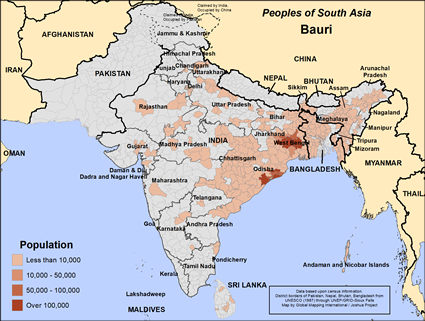Bauri in India

Photo Source:
Bethany World Prayer Center
|

Map Source:
People Group data: Omid. Map geography: UNESCO / GMI. Map Design: Joshua Project.
|
| People Name: | Bauri |
| Country: | India |
| 10/40 Window: | Yes |
| Population: | 1,997,000 |
| World Population: | 2,012,000 |
| Primary Language: | Bengali |
| Primary Religion: | Hinduism |
| Christian Adherents: | 0.33 % |
| Evangelicals: | 0.00 % |
| Scripture: | Complete Bible |
| Ministry Resources: | Yes |
| Jesus Film: | Yes |
| Audio Recordings: | Yes |
| People Cluster: | South Asia Dalit - other |
| Affinity Bloc: | South Asian Peoples |
| Progress Level: |
|
Introduction / History
The Bhil are the third largest and most widely distributed tribal group in India. Although the Bhil were once thought of as a single tribe, it is now clear that they consist of many subgroups, one of which is the Bauri, who live further east than the other Bhil groups. They live mainly in West Bengal. The name "Bhil" was probably derived from the word villu or billu, which in most Dravidian languages is the word for "bow. " The bow has long been a characteristic weapon of the Bhil because the tribesmen always carry their bows and arrows with them. The Bauria were traditionally hunters and gatherers. They relied primarily on bows and arrows for hunting, although they also used spears, slings, and axes. They gathered edible plants, roots, and fruits from the forests.
What Are Their Lives Like?
Unfortunately, extensive deforestation in their region has greatly diminished the forest resources. As a result, most of the Bauria are now settled farmers. Their primary crops include maize, millet, cucumbers, cotton, wild rice, lentils, and barley. Some of the Bauria have lost their land and now earn a living as hired laborers. Many of them have found jobs clearing forests or repairing roads. Since the Bauria do not weave cloth, make pottery, or work with metals, they are dependent on trade to obtain these types of items. The Bauri mark their village boundaries by tying bundles of grass to trees along the paths. Each village usually contains between three and forty families. The villagers live in houses that are set far apart from each other. Most of the houses are built on hills with their fields surrounding them. Most villages also have some land that is reserved for community use.
What Are Their Beliefs?
The Bauri are animists (believe that non-living objects have spirits) who have been heavily influenced by Hinduism. In fact, most of their Hindu and animistic practices have been so intertwined that it is difficult to separate them. Ancestor worship (worshiping the spirits of deceased relatives) is also quite popular. The village shamans (priests) attempt to appease the gods and mud idols by making sacrifices to them on stone altars. They also practice totemism, where they worship the spirit of a certain animal that is also the emblem of their people. The red-backed heron is the totem for the Bauri people.
What Are Their Needs?
There is a need for Christian believers who are filled with the fruit of the Holy Spirit to share God's love with the Bauri people. Prayer is the first step toward seeing them reached with the truth of the gospel.
Prayer Points
Pray for the Holy Spirit to give the Bauri people teachable and understanding hearts. Pray that a strong movement of the Holy Spirit will bring entire Bauri families into a rich experience of God's blessing. Pray for Bauri families to be drawn by the Holy Spirit to seek forgiveness, and to understand the adequacy of Christ's work on the cross. Pray for teams of believers to do sustained, focused prayer for the Lord to open the hearts of Bauri family leaders to experience God's blessing through a movement of family-based discovery Bible studies.